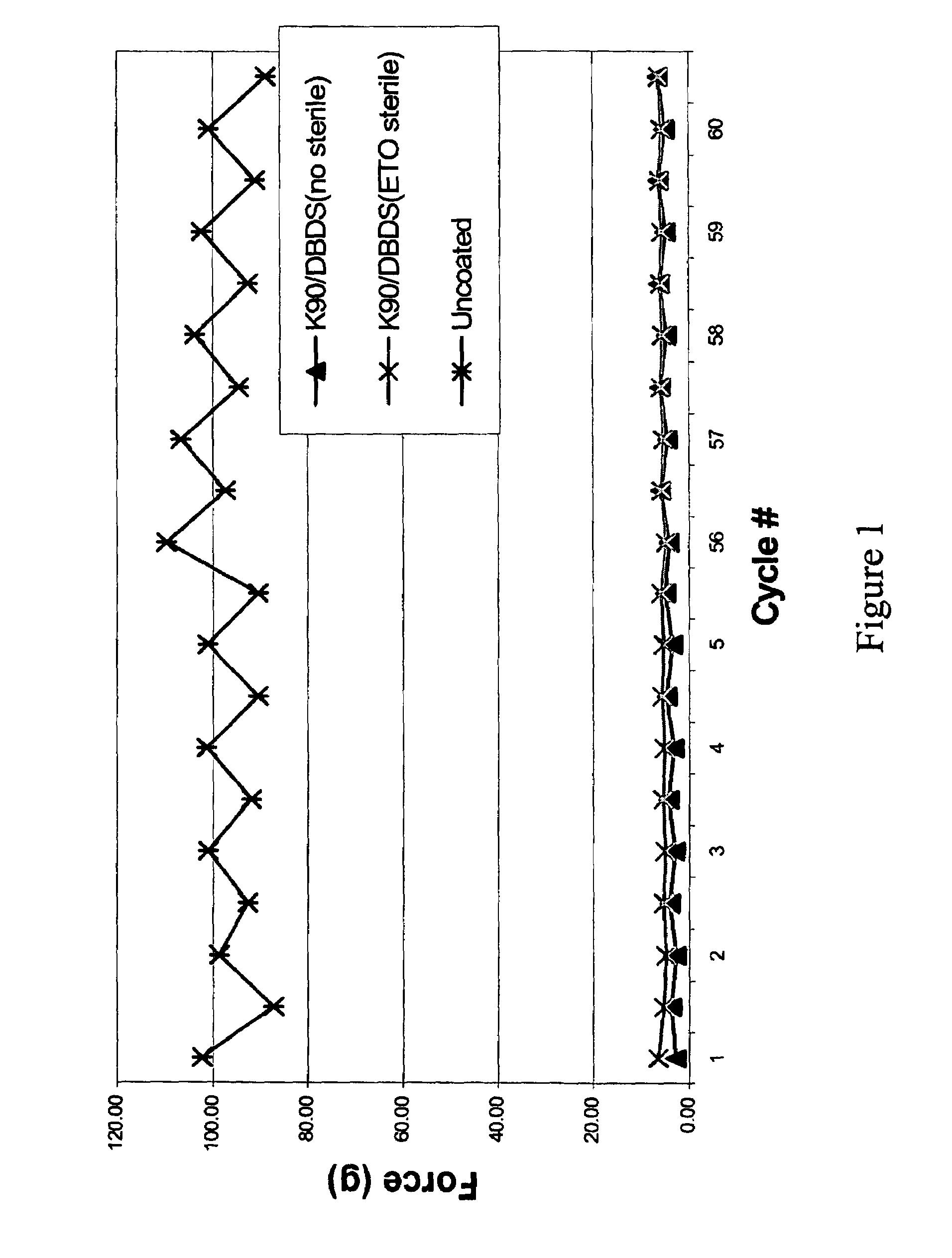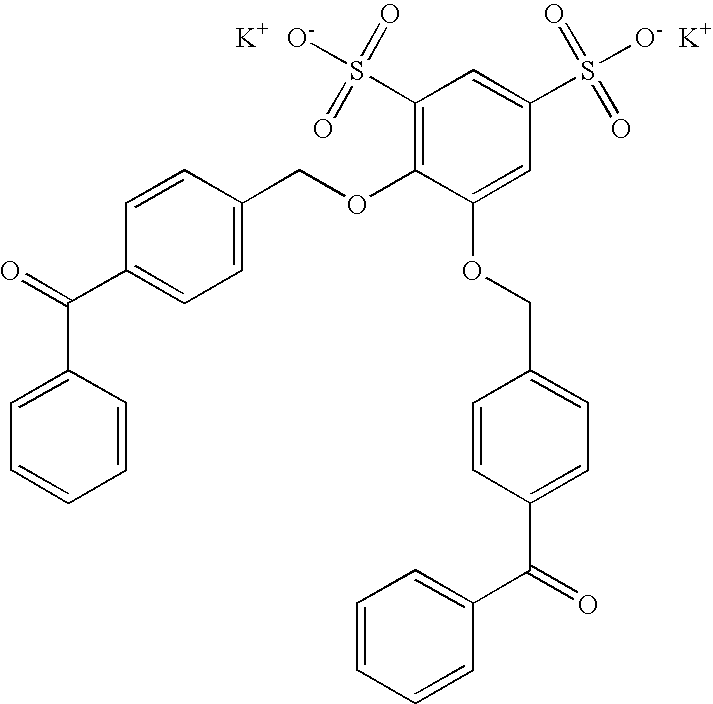Water-soluble coating agents bearing initiator groups
a technology of initiator group and coating agent, which is applied in the field of water-soluble coating agent bearing initiator group, can solve the problems of loss of biological activity, limited hydrophilic application usefulness, and lack of such attributes as speed, versatility, and ease of use, and achieves enhanced water solubility and broad applicability.
- Summary
- Abstract
- Description
- Claims
- Application Information
AI Technical Summary
Benefits of technology
Problems solved by technology
Method used
Image
Examples
example 1
Preparation of 4,5-bis(4-benzoylphenylmethyleneoxy) benzene-1,3-disulfonic acid disodium salt (DBDS) (Compound I)
[0099]4,5-bis(4-benzoylphenylmethyleneoxy) benzene-1,3-disulfonic acid disodium salt (DBDS) was prepared as follows. An amount (9.0 g, 0.027 moles) of 4,5-dihydroxy 1,3-benzene disulfonic acid disodium salt monohydrate was added to a 250 ml, 3 necked round bottom flask fitted with an overhead stirrer, gas inlet port, and reflux condenser. An amount (15 g, 0.054 moles) of 4-bromomethylbenzophenone (BMBP), 54 ml tetrahydrofuran (THF), and 42 ml deionized water were then added. The flask was heated with stirring under an argon atmosphere to reflux. The argon atmosphere was maintained during the entire time of refluxing.
[0100]After reflux was reached, 9.0 ml (6 N, 0.054 moles) of a sodium hydroxide solution was added through the reflux condenser. The reaction was stirred under reflux for 3 hours. After this time, a second portion of BMBP, 3.76 g (0.014 moles), and 3.6 ml (6 N...
example 2
Preparation of 2,5-bis(4-benzoylphenylmethyleneoxy) benzene-1,4-disulfonic acid dipotassium salt (DBHQ) (Compound II)
[0103]2,5-bis(4-benzoylphenylmethyleneoxy) benzene-1,4-disulfonic acid disodium salt (DBHQ) was prepared as follows. An amount (15.0 g, 0.043 moles) of 2,5-dihydroxy 1,4-benzene disulfonic acid dipotassium salt was added to a 500 ml, 3 necked round bottom flask fitted with an overhead stirrer, gas inlet port, and reflux condenser. An amount (23.75 g, 0.086 moles) of BMBP, 10.0 g (0.094 moles) of sodium carbonate, 90 ml of methanol, and 90 ml deionized water were then added. The flask was heated with stirring under an argon atmosphere to reflux. The argon atmosphere was maintained during the entire time of refluxing. The reaction was stirred under reflux for 2 hours.
[0104]A second portion of BMBP, 6.25 g (0.023 moles), and 2.65 g (0.025 moles) sodium carbonate were added. The reaction was continued under reflux for 2 more hours, after the second BMBP addition.
[0105]The...
example 3
Preparation of 2,5-bis(4-benzoylphenylmethyleneoxy) benzenesulfonic acid sodium and / or potassium salt (Compound E)
[0106]2,5-bis(4-benzoylphenylmethyleneoxy) benzenesulfonic acid sodium and / or potassium salt was prepared as follows. An amount (1.98 g, 0.0087 moles) of 2,5-dihydroxybenzene sulfonic acid potassium salt was added to a 100 ml, 3 necked round bottom flask fitted with an overhead stirrer, gas inlet port, and reflux condenser. An amount (4.75 g, 0.017 moles) of BMBP; 2.9 ml (0.017 moles) of 6N sodium hydroxide; 18 ml of methanol; and 14 ml of deionized water were then added. The flask was heated with stirring under an argon atmosphere to reflux. The argon atmosphere was maintained during the entire time of refluxing. The reaction was stirred under reflux for 1 hour.
[0107]A second portion of BMBP, 1.25 g (0.0045 moles), and 1.1 ml (0.0066 moles) of 6N sodium hydroxide were added. The reaction was continued under reflux for 1 more hour, after the second BMBP addition.
[0108]At...
PUM
| Property | Measurement | Unit |
|---|---|---|
| solubility | aaaaa | aaaaa |
| solubility | aaaaa | aaaaa |
| solubility | aaaaa | aaaaa |
Abstract
Description
Claims
Application Information
 Login to View More
Login to View More - R&D
- Intellectual Property
- Life Sciences
- Materials
- Tech Scout
- Unparalleled Data Quality
- Higher Quality Content
- 60% Fewer Hallucinations
Browse by: Latest US Patents, China's latest patents, Technical Efficacy Thesaurus, Application Domain, Technology Topic, Popular Technical Reports.
© 2025 PatSnap. All rights reserved.Legal|Privacy policy|Modern Slavery Act Transparency Statement|Sitemap|About US| Contact US: help@patsnap.com



